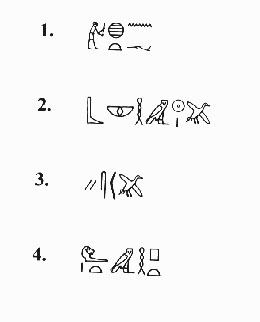 The names of the men in Nakht's "western gang".
The names of the men in Nakht's "western gang". The names of the men in Nakht's "western gang".
The names of the men in Nakht's "western gang".1. Nakht himself:
The name is written with five hieroglyphic signs. Do not forget that you read from right to left (although when they wanted, the Egyptians could also write from left to right) and you start with the sign at the top. The Egyptians did not record vowels, such as A, E, I or U.
The first hieroglyph (a ripple of water) is N, the second (a tree branch) is a combination of two sounds, KH and T, the third (the lid of a jar) is KH, the fourth (a loaf of bread) is T, and the last indicates that the original meaning of the word is "strong" (so Ipi's father was "Mr Strong"). It shows a strong man wielding a stick, but this sign is not pronounced. So the writing is quite complicated, like this:
(from right) N + KHT + KH + T + "strong man"
But the reading is simply N + KH + T = NKHT, and we insert A in order to be able to pronounce it, so "Nakht".
2. Paraemhab:
This name is written with seven hieroglyphic signs. The first (a flying duck) is a combination of two sounds, P and another which is a little like A (although it is not the same as our vowel A, it is a sound which does not exist in English), so P + A. The second (the sun) is equally difficult. It is again a combination of two sounds, R and another which is also a little like our A, but again does not exist in English, so R + A. The third sign is a short vertical stroke which is not pronounced. The fourth sign (an owl) is M. The fifth (twisted flax) reads H, the sixth (stone basin) is H+B, and the seventh (a leg) is B. But the fifth and the seventh signs only repeat what is written by the sixth sign and the last three hieroglyphs together do not say HHBB, only HB. This would be difficult to pronounce, so we say "hab". The writing of this name is again rather complicated, like this:
(from right)PA + RA + stroke + M + H + HB + B (Paraemhab)
The name means "The God Ra (Para) is in (em) Festival (hab)".
3. Panehesy:
The first sign is the same as in the name of Paraemhab, and reads in the same way, P + A. The second sign (a throw-stick) records three sounds, N + H + S. The third sign (a folded cloth) is S, and the two strokes at the end are Y.
So the name is written PA + NHS + S + Y, but reads only P + A + N + H + S + Y (Panehesy).
The name means "The Nubian".
4. Ptahemhat:
The first four signs are simple, P (a stool), T, H and M. The fifth sign (the forepart of a lion) reads H + A + T (once again, the second of these is not really A but resembles it a little). The sixth sign is T but only repeats the T of the preceding sign. The last sign, a stroke, is not pronounced at all.
So the name is written P + T + H + M + HAT + T + stroke (Ptahemhat).
The name means "The god Ptah (Ptah) is at (em) the front (hat)".